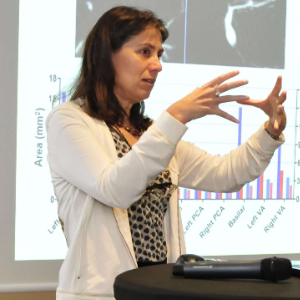Title : Discovery of markers for brain tumors starting from mouse models
Abstract:
Glioblastoma is a deadly brain tumor with a median survival of 1.3 years after surgery, radiotherapy and chemotherapy. The dismal prognosis is due to the propensity of the tumor to invade adjacent normal brain. Although next generation sequencing led to genomic landscaping of glioblastoma, there is little insight into the mechanism of neoplastic cell invasion, the detection of the invasive cells or their therapeutic targeting. To address these critical issues, we developed a murine model of invasive glioblastoma that mimics the human disease. Using a cancer stem-cell like human glioblastoma cell line in an orthotopic model, we isolated pairs of neoplastic cells growing either in the core of the tumor (Core cells) or away for the core, in the opposite hemisphere (Inv cells). A phenotypic assessment showed significantly decreased animal survival, increased cancer stemness and invasion but decreased proliferation of the Inv cells in comparison to Core cells. Activation of the PI3 kinase-Akt pathways characterized the Inv cells, whereas activation of the ERK/MAP kinase pathway was specific to Core cells. Microarray profiling of Core and Inv cells for differences of expression of mRNAs and microRNAs resulted in the identification of differentially expressed gene targets controlling metabolic pathways, cell-cell and cell-matrix adhesion and cell differentiation. Two categories of targets potentially relevant for diagnostic and therapy were further addressed: enzymes involved in metabolic pathways and receptor molecules expressed at the plasma membrane of neoplastic cells. These translational findings and the implications for the diagnosis and therapy of glioblastoma will be discussed.




